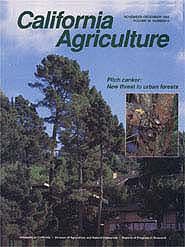


University of California
California Agriculture



|
|||
|
|||

Pitch canker: New threat to urban forests
Cover:
Shown in inset, the fungal disease pitch canker is rapidly killing California's Monterey pine, and has spread as far north as Mendocino County. Photo by Jack Kelly Clark
November-December 1994
Volume 48, Number 6 News and opinion |
|||
|
University of California, 1301 S. 46th St., Bldg. 478 Richmond, CA
|